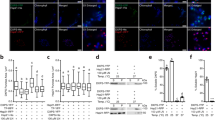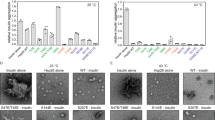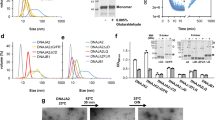Abstract
The 2.7 Å structure of wheat HSP16.9, a member of the small heat shock proteins (sHSPs), indicates how its α-crystallin domain and flanking extensions assemble into a dodecameric double disk. The folding of the monomer and assembly of the oligomer are mutually interdependent, involving strand exchange, helix swapping, loose knots and hinged extensions. In support of the chaperone mechanism, the substrate-bound dimers, in temperature-dependent equilibrium with higher assembly forms, have unfolded N-terminal arms and exposed conserved hydrophobic binding sites on the α-crystallin domain. The structure also provides a model by which members of the sHSP protein family bind unfolded substrates, which are involved in a variety of neurodegenerative diseases and cataract formation.
This is a preview of subscription content, access via your institution
Access options
Subscribe to this journal
Receive 12 print issues and online access
$189.00 per year
only $15.75 per issue
Buy this article
- Purchase on Springer Link
- Instant access to full article PDF
Prices may be subject to local taxes which are calculated during checkout




Similar content being viewed by others
References
Bruey, J.M. et al. Nature Cell. Biol. 2, 645–652 (2000).
Horwitz, J. Semin. Cell Devel. Biol. 11, 53–60 (2000).
Derham, B.K. & Harding, J.J. Prog. Retinal Eye Res. 18, 463–509 (1999).
Clark, J.I. & Muchowski, P.J. Curr. Opin. Struct. Biol. 10, 52–59 (2000).
Lee, G.J., Roseman, A.M., Saibil, H.R. & Vierling, E. EMBO J. 16, 659–671 (1997).
Ehrnsperger, M., Gräber, S., Gaestel, M. & Buchner, J. EMBO J. 16, 221–229 (1997).
Lee, G.J. & Vierling, E. Plant Physiol. 122, 189–197 (2000).
Kappe, G. et al. Biochim. Biophys. Acta 1520, 1–6 (2001).
Waters, E.R. & Vierling, E. Mol. Biol. Evol. 16, 127–139 (1999).
MacRae, T.H. Cell. Mol. Life Sci. 57, 899–913 (2000).
Bova, M.P., McHaourab, H.S., Han, Y. & Fung, B.K.K. J. Biol. Chem. 275, 1035–1042 (2000).
Studer, S. & Narberhaus, F. J. Biol. Chem. 275, 37212–37218 (2000).
Sugiyama, Y. et al. J. Biol. Chem. 275, 1095–1104 (2000).
Haley, D.A., Bova, M.P., Huang, Q.L., McHaourab, H.S. & Stewart, P.L. J. Mol. Biol. 298, 261–272 (2000).
Kim, K.K., Kim, R. & Kim, S.H. Nature 394, 595–599 (1998).
Haslbeck, M. et al. EMBO J. 18, 6744–6751 (1999).
de Jong, W.W., Caspers, G.-J. & Leunissen, J.A.M. Int. J. Biol. Macromol. 22, 151–162 (1998).
Liddington, R.C. et al. Nature 354, 278–284 (1991).
Bax, B. et al. Nature 347, 776–780 (1990).
Schlunegger, M.P., Bennett, M.J. & Eisenberg, D. Adv. Protein Chem. 50, 61–122 (1997).
Feil, I.K., Malfois, M., Hendle, J., van der Zandt, H. & Svergun, D.I. J. Biol. Chem. 276, 12024–12029 (2001).
Weaver, A.J., Sullivan, W.P., Felts, S.J., Owen, B.A.L. & Toft, D.O. J. Biol. Chem. 275, 23045–23052 (2000).
Koteiche, H.A. & Mchaourab, H.S. J. Mol. Biol. 294, 561–577 (1999).
Saibil, H. Curr. Opin. Struct. Biol. 10, 251–258 (2000).
Rao, C.M. et al. Int. J. Biol. Macromol. 22, 271–281 (1998).
van den Oetelaar, P.J.M., van Someren, P.F.H.M., Thomson, J.A., Siezen, R.J. & Hoenders, H.J. Biochemistry 29, 3488–3493 (1990).
Sharma, K.K., Kumar, G.S., Murphy, A.S. & Kester, K. J. Biol. Chem. 273, 15474–15478 (1998).
Smith, J.B., Liu, Y. & Smith, D.L. Exp. Eye Res. 63, 125–128 (1996).
Shroff, N.P., Bera, S., Cherian-Shaw, M. & Abraham, E.C. Mol. Cell. Biochem. 220, 127–133 (2001).
Lee, G.J., Pokala, N. & Vierling, E. J. Biol. Chem. 270, 10432–10438 (1995).
Helm, K.W., Lee, G.J. & Vierling, E. Plant Physiol. 114, 1477–1485 (1997).
Otwinowski, Z. & Minor, W. Methods Enzymol. 276, 307–326 (1997).
Collaborative Computational Project, Number 4. Acta Crystallogr. D 50, 760–763 (1994).
Weeks, C.M. & Miller, R. J. Appl. Crystallogr. 32, 120–124 (1999).
de La Fortelle, E. & Bricogne, G. Methods Enzymol. 276, 472–494 (1997).
Jones, T.A., Zou, J.-Y., Cowan, S.W. & Kjelgaard, M. Acta Crystallogr. A 47, 110–119 (1991).
Brünger, A.T. et al. Acta Crystallogr. D 54, 905–921 (1998).
Laskowski, R.A., MacArthur, M.W., Moss, D.S. & Thornton, J.M. J. Appl. Crystallogr. 26, 283–291 (1993).
Kraulis, P.J. J. Appl. Crystallogr. 24, 946–950 (1991).
Merrit, E.A. & Murphy, M.E.P. Acta Crystallogr. D 50, 869–873 (1994).
Nicholls, A., Sharp, K.A. & Honig, B. Proteins 11, 281–296 (1991).
Acknowledgements
We are especially indebted to G. Lee and A. Basak, whose work on pea HSP18.1 provided the basis for these structural studies on the related wheat HSP16.9. We also acknowledge D. Moss, I. Tickle and H. Driessen for valuable discussions during the structure determination and O. Bateman for mass spectrometry measurements. We thank G. Leonard for his help during data collection, and staff at the ESRF, the EMBL outstation at DESY, Hamburg and of the CLRC of Daresbury Laboratory, Warrington, for their support of the work at those facilities. Research in the laboratory of E.V. was funded by grants from the National Institutes of Health and the U.S. Department of Agriculture (NRICGP). During preparation of this manuscript, E.V. is grateful for support from the National Science Foundation (POWRE Award), the Guggenheim Foundation and the Dutch National Science Foundation. Financial support of the Medical Research Council (London) to C.S. and R.v.M. is very gratefully acknowledged.
Author information
Authors and Affiliations
Corresponding author
Rights and permissions
About this article
Cite this article
van Montfort, R., Basha, E., Friedrich, K. et al. Crystal structure and assembly of a eukaryotic small heat shock protein. Nat Struct Mol Biol 8, 1025–1030 (2001). https://doi.org/10.1038/nsb722
Received:
Accepted:
Published:
Issue Date:
DOI: https://doi.org/10.1038/nsb722
This article is cited by
-
RNA interference-induced silencing of the SlHSP17.7 gene delays fruit ripening in tomato
Journal of Plant Biochemistry and Biotechnology (2023)
-
Is the lipochaperone activity of sHSP a key to the stress response encoded in its primary sequence?
Cell Stress and Chaperones (2023)
-
Identification of the DcHsp20 gene family in carnation (Dianthus caryophyllus) and functional characterization of DcHsp17.8 in heat tolerance
Planta (2022)
-
Structure–function relationship of α-crystallin in the context of vertebrate lens evolution and its role in eye disorders
Journal of Proteins and Proteomics (2022)
-
Elucidation of the mechanism of subunit exchange in αB crystallin oligomers
Scientific Reports (2021)



